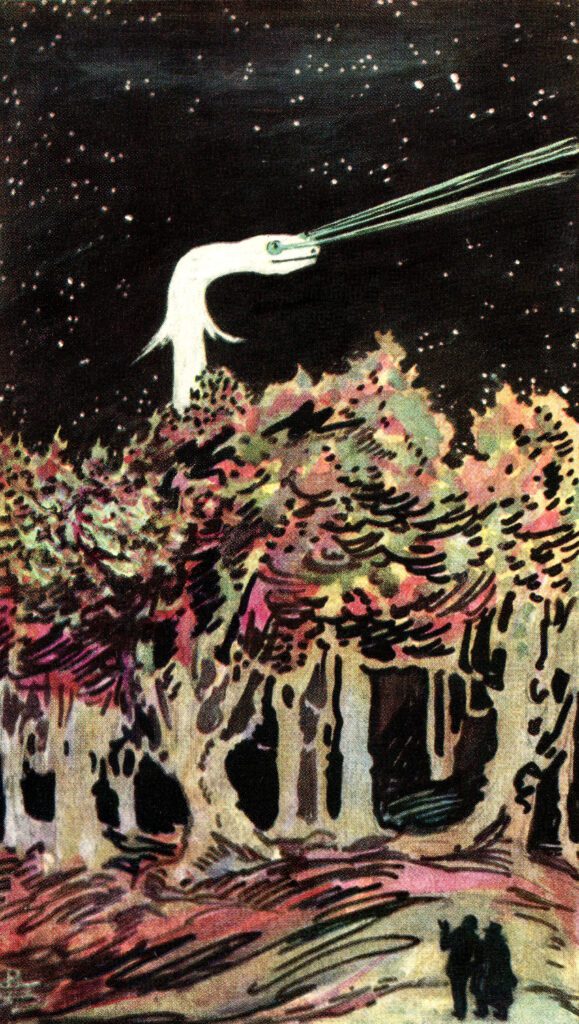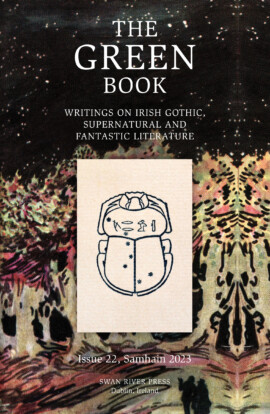Contents
“Editor’s Note” – Brian J. Showers
“Bram Stoker and I” – Mike Mignola
“A Mystery of Bram Stoker” – Leslie Shepard
“Bram Stoker as Amanuensis for Henry Irving” – Douglas A. Anderson
“Black Spirits and White” – Henry Irving
“Four Romances” – Paul Murray
“Greater Love” – Bram Stoker
“Our New House” – Bram Stoker
“A Yellow Duster” – Bram Stoker
“The Way of Peace” – Bram Stoker
“Rules for Domestic Happiness” – Charlotte M. B. Stoker
“Bram Stoker and Another Dracula” – Brian J. Showers
“Bram Stoker: A Biographical Note” – Ralph Shirley
“In Memoriam: David Lass” – Albert Power
“Notes on Contributors”
 Editor’s Note #22
Editor’s Note #22
I thought this moment might never come. Perhaps on some levels I was even avoiding it due to an oversaturation of the blood-stained, opera-cloaked market. But at long last, we seem to have a Bram Stoker issue of The Green Book in our hands! Some of the keen-eyed might have realised this from the cover, which features as the background Pamela Colman Smith’s illustration for The Lair of the White Worm (1911), while the inset image is a detail from the printed boards of The Jewel of Seven Stars (1903). (It dawns on me as I write this that, while there is plenty of White Worm action herein, there’s nothing about Jewel—however, a scarab does make an appearance . . . )
The first piece in this issue is an appreciation of “The Judge’s House” (1891), and an accompanying illustration, by Mike Mignola, a writer and artist whose memorable creation Hellboy boasts direct lineage from the works of Stoker. This short essay first appeared as the introduction to the Swan River booklet The Definitive Judge’s House (2011), now long out of print. I thought it might be nice to give it another outing.
Next is another personal reminiscence transcribed from a lecture given by Leslie Shepard in 2000. In it, Shepard describes a situation familiar to many book collectors: the rare volume that “got away”. Shepard also outlines a mystery about Stoker, the first of three Stoker-related mysteries to be found in this issue. Those of a certain vintage might recall that Leslie Shepard co-founded the Bram Stoker Society, here in Dublin, in 1980. We’ll come back to the Bram Stoker Society in a moment.
Douglas A. Anderson submitted a year ago an uncollected piece entitled “Black Spirits and White” by Henry Irving—or perhaps not? As Anderson conjectures in his brief note introducing the tale, there is a possibility that Stoker himself might have penned the piece (Mystery #2). Alas, we will likely never learn the answer, however you’re welcome to draw your own conclusion.
After this, we’re reprinting in its entirety another Swan River booklet from the out-of-print Stoker Series: Four Romances by Mr. Bram Stoker (2009). Paul Murray introduces the quartet of stories, noting that they showcase a different side to Stoker’s literary output than readers might be used to: the domestic drama. Augmenting this selection is a short piece by Stoker’s mother, Charlotte, and her rules for domestic happiness. The title pretty much says it all. (As an aside, I posited in the preface to Old Hoggen and Other Adventures (2017) that Stoker might have been planning a collection of “romance” stories prior to his death. For the curious, this volume might have contained stories such as “When the Sky Rains Gold” (1894), “Bengal Roses” (1898), “A Young Widow” (1899), and three of the four stories included in this issue—“Our New House” sneaked its way into Old Hoggen as an adventure. Who the audience is for an entire collection of Stoker’s romances, curious though they may be to the scholar, I am not entirely certain. Anyhow, see what you think.)
I hope you’ll allow me a further indulgence, but I’m running one of my own articles in this issue—an essay with which readers of the late, lamented journal Wormwood might already be familiar. In “Bram Stoker and Another Dracula”, I discuss whether or not Stoker ever intended to write a sequel to Dracula (Mystery #3). It’s a question that fascinates me, and I think I’ve come up with a pretty good answer—but we can never know for sure. This essay was inspired by a paraphrased “interview” with Stoker that appeared in an issue of The Occult Review, just months before his passing in April 1912. In this piece, Mr. Stoker divulges some curious titbits, which I make use of in my own essay. I won’t spoil the surprise, but I thought it worth reprinting this interview in its entirety as well.
I’m sad to report the passing in October 2022 of David Lass, who, along with Leslie Shepard and John Leahy, co-founded the Bram Stoker Society at Trinity College Dublin. An early member of the society, Albert Power, who was present for its inaugural meeting, has provided a memorial tribute to David Lass.
And so I would like to dedicate this issue to not only David, but also Leslie and John. Along with the aforementioned Wormwood, the journal of the Bram Stoker Society was a definitive inspiration for The Green Book.
And finally, to all those aficionados of The Jewel of Seven Stars: better luck next time.
Brian J. Showers
Æon House, Dublin
12 July 2023
Brian J. Showers
Brian J. Showers is originally from Madison, Wisconsin. He has written short stories, articles, and reviews for magazines such as Rue Morgue, Ghosts & Scholars, and Supernatural Tales. His short story collection, The Bleeding Horse, won the Children of the Night Award in 2008. He is also the author of Literary Walking Tours of Gothic Dublin (2006), the co-editor of Reflections in a Glass Darkly: Essays on J. Sheridan Le Fanu (2011), and the editor of The Green Book. Showers also edited four volumes of Uncertainties anthology series, and co-edited with Jim Rockhill, the Ghost Story Award-winning anthology Dreams of Shadow and Smoke. He lives in Dublin, Ireland.
Read more
The Green Book 22 (Samhain 2023) edited by Brian J. Showers. Cover art from The Jewel of Seven Stars (1903) and The Lair of the White Worm (1911); cover design by Meggan Kehrli; editor’s note by Brian J. Showers; edited by Brian J. Showers; copyedited by Jim Rockhill; typeset by Steve J. Shaw; published by Swan River Press at Æon House.
Paperback: Published on 28 September 2023; limited to 250 copies; 108 pages; digitally printed on 80 gsm paper; issued with one postcard; ISSN: 2009-6089.

 About The Green Book
About The Green Book
Aimed at a general readership and published twice-yearly, The Green Book is Swan River Press’s house journal that features commentaries, articles, and reviews on Irish Gothic, Supernatural and Fantastic literature.
Certainly favourites such as Bram Stoker and John Connolly will come to mind, but hopefully The Green Book also will serve as a pathway to Ireland’s other notable fantasists: like Fitz-James O’Brien, Charlotte Riddell, Lafcadio Hearn, William Allingham, J. Sheridan Le Fanu, Cheiro, Harry Clarke, Dorothy Macardle, Lord Dunsany, Elizabeth Bowen, C. S. Lewis, Mervyn Wall, Conor McPherson . . . and this list is by no means exhaustive.
It should be noted that the word “Irish” in the journal’s title should be understood as inclusive rather than exclusive. The Green Book will also feature essays on Irish themes—even if by non-Irish authors. We hope that you will find something of interest here, for there is much to explore.
The Green Book is open for submissions.
Praise for The Green Book
“A welcome addition to the realm of accessible nonfiction about supernatural horror.” – Ellen Datlow
“Serious aficionados of the weird should also consider subscribing to The Green Book.” – Michael Dirda
“An exceptionally well-produced periodical.” – S. T. Joshi
“[A] wonderful exploration of a weird little corner of literature, and a great example of how careful editing can make even the most obscure subject fascinating and entertaining beyond all expectations.” – The Agony Column
“Eminently readable . . . [an] engaging little journal that treads the path between accessibility and academic depth with real panache.” – Black Static
“The overall feel here is not of fusty excavation in a small corner of the literary world, but of exploration on a broad front that continues to unearth intriguing finds.” – Supernatural Tales


 Editor’s Note #22
Editor’s Note #22

 About The Green Book
About The Green Book